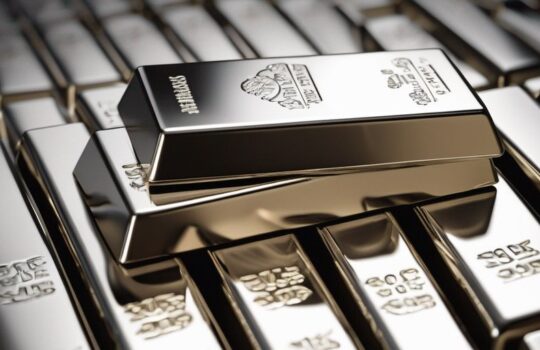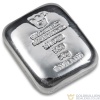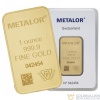The Impact of High Gold Prices on Investment Trends
In recent years, gold prices have experienced significant fluctuations, reaching record highs and impacting investment trends. This section will delve into the recent trends in gold investment, explore the reasons behind the decrease in gold ETFs, and analyze the role of geopolitical events in shaping gold prices.
Gold has long been considered a safe haven asset during times of economic uncertainty. Investors often turn to gold as a hedge against inflation or as a store of value when other investments are volatile. However, the increase in gold prices has led to a shift in investment trends.
One notable trend is the decrease in gold exchange-traded funds (ETFs). Gold ETFs are investment vehicles that track the price of gold and allow investors to gain exposure to the precious metal without physically owning it. These ETFs have seen a decline in popularity due to several factors.
One reason for the decrease in gold ETFs is investor behavior. As gold prices rise, some investors may choose to diversify their portfolios by exploring alternative investment options. They may opt for other commodities or assets that offer higher potential returns or better risk-adjusted performance. Additionally, market trends play a role in this shift as well.
Geopolitical events also play a crucial role in shaping gold prices and subsequently impacting investment trends. Geopolitical tensions, such as trade disputes or political instability, can create uncertainty and drive investors towards safe-haven assets like gold. The anticipation or occurrence of these events can cause fluctuations in demand for gold and influence its price.
Understanding these dynamics is essential for investors looking to navigate the current landscape of high gold prices. By analyzing recent trends in gold investment, exploring the reasons behind the decrease in gold ETFs, and considering the impact of geopolitical events on gold prices, investors can make informed decisions about their portfolios.
In the following sections, we will delve deeper into each aspect mentioned above – examining alternative investment options contributing to the decrease in gold ETFs, analyzing specific geopolitical events and their influence on gold prices, and understanding the relationship between interest rates and gold bullion.
Reasons for the Decrease in Gold ETFs
Market trends and investor behavior
The decrease in gold exchange-traded funds (ETFs) can be attributed to various market trends and investor behavior. Understanding these factors is crucial in comprehending the shift away from gold ETFs.
One of the key market trends impacting gold ETFs is the rise of alternative investment options. As gold prices have soared, investors have sought out other avenues that offer potentially higher returns or better risk-adjusted performance. This has led to a diversification of investment portfolios, with investors exploring commodities like silver, platinum, or palladium, as well as other assets such as cryptocurrencies or real estate.
Additionally, investor behavior plays a significant role in the decrease of gold ETFs. When gold prices are high, some investors may choose to take profits and sell their positions in gold ETFs. This selling pressure can lead to a decline in demand for these investment vehicles. Moreover, some investors may opt for physical ownership of gold rather than holding it through an ETF. They may prefer the tangibility and security that comes with owning physical bullion.
Another factor contributing to the decrease in gold ETFs is the overall sentiment towards the economy and financial markets. During periods of economic stability and optimism, investors may be more inclined to invest in riskier assets such as stocks or bonds rather than safe-haven assets like gold. The perception of economic growth and positive market conditions can divert capital away from gold ETFs.
In summary, market trends and investor behavior are significant drivers behind the decrease in gold ETFs. The rise of alternative investment options, investor profit-taking during high gold prices, preference for physical ownership, and overall sentiment towards the economy all contribute to this shift away from these investment vehicles.
In the next section, we will delve deeper into analyzing alternative investment options that have gained popularity amidst decreasing interest in gold ETFs and examine their impact on these funds.
The Role of Geopolitical Events on Gold Prices
Understanding geopolitical events
Geopolitical events play a significant role in shaping gold prices. These events encompass political, economic, and social developments that occur on a global scale and have the potential to create uncertainty and volatility in financial markets. Understanding the significance of geopolitical events is crucial in analyzing their impact on gold prices.
Geopolitical events can range from trade disputes and political unrest to natural disasters and global pandemics. When these events occur, they often lead to increased market uncertainty as investors seek safe-haven assets to protect their wealth. Gold has historically been considered a reliable store of value during times of crisis, making it an attractive investment option.
The impact of geopolitical events on gold prices can be twofold. First, the anticipation or occurrence of such events can drive up demand for gold as investors flock to safe-haven assets. This increased demand can push gold prices higher. Second, the aftermath of these events may result in long-term economic or political changes that continue to influence gold prices even after the initial event has passed.
Case studies of geopolitical events
Examining specific case studies provides valuable insights into how geopolitical events have influenced gold prices in the past. One notable example is the global financial crisis of 2008. As the crisis unfolded, investors lost confidence in traditional financial institutions and turned to gold as a safe haven. This surge in demand drove up gold prices significantly.
Another case study is Brexit, the United Kingdom's decision to leave the European Union. Leading up to the referendum and following its outcome, there was widespread uncertainty surrounding the future economic landscape. Investors sought refuge in gold as a hedge against this uncertainty, resulting in a spike in gold prices.
Analyzing patterns and trends observed in these cases helps investors understand how geopolitical events can impact gold prices over time. It highlights the importance of staying informed about global developments and their potential implications for financial markets.
In the next section, we will explore the relationship between interest rates and gold bullion, providing further insights into factors that influence gold prices.
The Impact of Interest Rates on Gold Bullion
Understanding the relationship between interest rates and gold prices
The relationship between interest rates and gold prices is complex, but there is a general inverse correlation between the two. When interest rates are low, it becomes less attractive to hold cash or invest in fixed-income assets such as bonds. As a result, investors may turn to alternative investments like gold, which has historically been seen as a store of value.
Low-interest-rate environments often coincide with periods of economic uncertainty or financial instability. During these times, investors seek safe-haven assets that can preserve their wealth. Gold, with its intrinsic value and limited supply, tends to be an appealing option. As demand for gold increases, its price tends to rise.
Conversely, when interest rates rise, the opportunity cost of holding non-yielding assets like gold becomes higher. Investors may opt for other investments that offer higher potential returns or income-generating opportunities. This increased demand for alternative investments can put downward pressure on gold prices.
Factors influencing interest rates
Several key factors influence interest rates and subsequently impact gold bullion prices. Central banks play a crucial role in determining short-term interest rates through monetary policy decisions. When central banks raise or lower interest rates, it affects borrowing costs and overall economic activity.
Economic indicators such as inflation levels, GDP growth rates, and employment data also influence interest rate decisions. Higher inflation expectations may prompt central banks to raise interest rates to curb inflationary pressures. Strong economic growth can lead to higher interest rates as well.
Moreover, geopolitical events can indirectly affect interest rates by creating uncertainty in financial markets. In times of geopolitical turmoil or global economic instability, central banks may respond by adjusting monetary policy to stabilize their respective economies.
All these factors collectively contribute to changes in interest rates which have an impact on the demand for and price of gold bullion.
In the next section, we will provide valuable tips for investors considering buying gold bullion in light of the factors discussed so far in this blog post.
Tips for Investors Considering Buying Gold Bullion
Factors to consider before buying gold bullion
Before investing in gold bullion, it is essential to consider several factors to make informed decisions. Understanding the market conditions and trends is crucial in determining the timing and potential returns of your investment. Here are some key factors to consider:
-
Market conditions: Stay updated on the current state of the gold market. Monitor factors such as supply and demand dynamics, geopolitical events, and economic indicators that can influence gold prices.
-
Trends: Analyze historical price trends and patterns in the gold market. This can provide insights into potential future price movements and help you make more informed investment decisions.
-
Risk assessment: Evaluate the risks associated with investing in gold bullion. While gold is often considered a safe-haven asset, it is not immune to price fluctuations or market volatility. Consider your risk tolerance and diversify your portfolio accordingly.
-
Potential returns: Assess the potential returns on your investment in gold bullion. Historical performance can provide an indication of past returns, but it's important to remember that past performance does not guarantee future results.
Choosing the right form of gold bullion
When buying gold bullion, there are various forms available, each with its own characteristics and considerations. Here are some factors to keep in mind when choosing the right form of gold bullion:
-
Purity: Check the purity level of the gold bullion you intend to purchase. The most common purity levels are 24 karat (99.9% pure) or 22 karat (91.7% pure). Higher purity levels generally command higher prices.
-
Weight: Determine how much weight of gold bullion you want to invest in based on your budget and investment goals. Gold bars typically come in larger weights, while coins offer smaller denominations suitable for individual investors.
-
Storage options: Consider how you plan to store your gold bullion securely. Options include keeping it at home in a safe or using professional storage services provided by banks or specialized vaults.
-
Authenticity: Ensure that you purchase gold bullion from reputable dealers who provide proper certification and authentication for their products.
By considering these factors before buying gold bullion, investors can make more informed decisions aligned with their financial goals and risk tolerance.
Conclusion
In conclusion, high gold prices have had a significant impact on investment trends, particularly in the decrease of gold exchange-traded funds (ETFs). Investors have been exploring alternative investment options and diversifying their portfolios to adapt to changing market conditions. Geopolitical events play a crucial role in shaping gold prices, as they create uncertainty and drive investors towards safe-haven assets like gold.
Understanding the relationship between interest rates and gold bullion is also essential for investors. Low-interest-rate environments tend to make gold more attractive as an investment option, while rising interest rates can divert capital away from non-yielding assets like gold.
For investors considering buying gold bullion, it is important to evaluate market conditions, assess risks, and consider potential returns. Choosing the right form of gold bullion involves factors such as purity, weight, and storage options.
Overall, investing in gold bullion requires careful consideration of various factors and staying informed about market dynamics. By understanding the impact of high gold prices on investment trends, recognizing the role of geopolitical events in shaping gold prices, and following valuable tips for buying gold bullion, investors can make informed decisions aligned with their financial goals.
Remember that investing in any asset carries risks, and it's always advisable to consult with a financial advisor or do thorough research before making any investment decisions.











